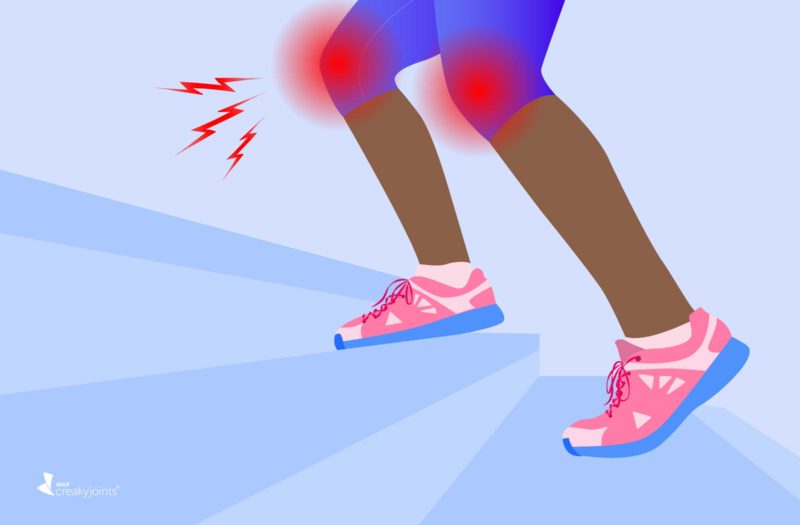If you live in a multi-story home or walk-up apartment, you know just how painstaking it can be to walk up and down stairs if you have arthritis in your knees. It may have gotten to the point of your avoiding the stairs altogether — or dreaming of moving to a one-story home.
Walking up and down steps causes pain in tender knee joints because of how your weight shifts between your legs as you climb.
“Climbing stairs causes more force to go through the leg than walking does,” says occupational therapist Julie Dorsey, OTD, OTR/L, an Associate Professor of Occupational Therapy at Ithaca College in Ithaca, New York. “That can irritate already inflamed joints.”
Knee pain with stair climbing is so common that it can be one of the first clues that someone actually has osteoarthritis in the knee. In a 2014 study published in the journal Arthritis Care & Research, researchers reviewed the pain ratings of nearly 5,000 participants with or at high risk of osteoarthritis when walking, using stairs, in bed, sitting or lying down, and standing up.
The activity that caused them to cross the threshold from “no pain” to “some pain” most often was going up and down stairs.
Knee pain is most likely to first appear during weight-bearing activities that involve bending of the knee, such as climbing stairs.
“I’ve had a lot of patients who have tried to move to a one-story place just because of their knee pain, so it’s pretty prevalent,” says Deeba Minhas, MD, a rheumatologist at Michigan Medicine in Ann Arbor, Michigan. “There are simple ways you can adjust your body mechanics to put a lot less strain on your joints.”
However, there are a few important ways you can make using stairs a little easier on your joints — without forever swearing off stairs. Follow these strategies to make navigating stairs easier and less painful.
1. Go up with your stronger leg, and down with the other
When you’re climbing up stairs, lead with your stronger leg (or the one that causes you less knee pain). As you go back down the stairs, lead with your other leg.
“When you’re going up the stairs, you have to shift your entire body weight against gravity, so you want to have the strongest leg ready to transfer all that weight onto,” says Dorsey. “When you’re going down the stairs, you want to lead with your weaker leg because you have the advantage of gravity.”
2. Always use the handrail
If your staircase has a handrail, be sure to use it. By allocating some of the weight from your legs to the handrail, you take a little bit of pressure off your knees.
3. Put your entire foot on the step of the stairs
Narrow steps can be especially tricky if you have arthritis because they don’t allow your full foot onto each step. It’s important to put your foot fully on each step as you climb up stairs, so you can push off the step using your heel rather than the ball of your foot.
“If you push up from your heel, that will shift the work from the front of your knees and quads — which may cause pain — to your glutes, which are stronger muscles,” says Dr. Minhas.
It’s also important to wear supportive shoes when you climb up and down stairs. If the arches of your feet collapse flat when you stand, it pushes your knees inward, which can cause pain and stress in your knees.
“Having your knees go inward is one of the worst things you can do when going up stairs, so look for shoes that have good arch support and that you can walk around at home in,” says Dr. Minhas. “That will counteract the natural tendency for the arch to collapse.”
Consider getting a new pair of “indoor shoes” just for wearing at home. This will reduce foot pain that comes from spending too much time barefoot. Foot pain can exacerbate knee pain.
4. Carry items in the right bags
If you need to carry groceries or any other items up stairs, reconsider the bag you use to transport them. Skip the heavy grocery and tote bags. “Try using a messenger bag or even a backpack, so you can still hold onto the handrail,” says Dorsey. “That can help to take some pressure off of the legs.”
Pay attention to your body’s pain signals and take a break if you need to. As a general rule, you should take breaks during a task if you tend to experience pain for more than two hours after completing it, per UW Medicine Orthopaedics and Sports Medicine. When it comes to carrying groceries up stairs, that may mean taking only the perishable items at first and going back for the pantry items later.
Also, don’t try to walk up the stairs sideways, even if you’re carrying something heavy: This requires you to use muscles on the outer parts of the leg that are weaker and may not be as reliable, says Dorsey. This can make you less stable, especially if there’s no handrail available.
5. Get up to move regularly throughout the day
When you’re stiff, it’s more difficult to tackle everyday tasks like climbing stairs. That’s why it’s important to get up and move regularly, especially during COVID-19 when you may be spending more time at home than usual.
“Sitting a lot turns your knees inward, so practice opening up the hip area during the day to keep that area more flexible,” says Dr. Minhas. “It’ll be easier to go up the stairs because you won’t feel as tight.”
Simply sitting at the edge of a chair and dangling your legs back and forth can be a helpful exercise.
“It’s important to get joint fluid to the knee area,” says Dr. Minhas. “Moving through your range of motion by swinging your legs back and forth can help.”
In general, getting enough physical activity can increase your strength and flexibility, reduce joint pain, and help fight fatigue, according to the Mayo Clinic. That, in turn, can help make climbing up and down stairs feel less overwhelming.
6. Do simple exercises to strengthen your legs
There are also targeted exercises you can do to strengthen your leg muscles, which will make it easier to climb up and down stairs.
“The bones on each side of your knee joint are like metal rods, and you’re supposed to have cartilage that acts like lubricant between them, but [in osteoarthritis] the cartilage wears away over time,” says Dr. Minhas. “As a result, you feel pain when they rub against each other. Strengthening the muscles that support your joints will anchor your bones, so they’re not hitting each other as much.”
A number of exercises can help to strengthen your legs. Dorsey recommends these two simple exercises, in particular:
- Tippy-Toe Raises: Rise up on your tippy-toes for 10 to 15 seconds as you hold on to a counter or dresser for stability. Lower back down. That’s one rep; do 10 reps total.
- Leg Raises: While standing and holding on to a counter or dresser for stability, raise one leg a few inches off the ground by bending at the knee (similar to if you were taking a step on the stairs). Lower your foot back to the ground. That’s one rep; do five reps on each side.
Both of these exercises will build your strength and balance. Of course, the reps listed above are only suggestions, and it’s important to do what’s right for your own body. For instance, you might rise up on your tippy toes for just five seconds to start — or you may want to increase your leg raises to 10 on each side.
Speak to your doctor before starting a new workout regimen to make sure the exercises you are doing are appropriate for your condition.
Not Sure What’s Causing Your Pain?
Check out PainSpot, our pain locator tool. Answer a few simple questions about what hurts and discover possible conditions that could be causing it. Start your PainSpot quiz.
Exercise helps ease arthritis pain and stiffness. Mayo Clinic. December 19, 2018. October 2, 2020. https://www.mayoclinic.org/diseases-conditions/arthritis/in-depth/arthritis/art-20047971.
Hensor EM, et al. Toward a Clinical Definition of Early Osteoarthritis: Onset of Patient-Reported Knee Pain Begins on Stairs. Data From the Osteoarthritis Initiative. Arthritis Care & Research. July 29, 2014. https://www.ncbi.nlm.nih.gov/pmc/articles/PMC4296218.
Interview with Deeba Minhas, MD, a rheumatologist at Michigan Medicine in Ann Arbor, Michigan
Interview with Julie Dorsey, OTD, OTR/L, an Associate Professor of Occupational Therapy at Ithaca College in Ithaca, New York
Using Joints Wisely. UW Medicine Orthopaedics and Sports Medicine. October 1, 2020. https://orthop.washington.edu/patient-care/articles/arthritis/using-joints-wisely.html.






